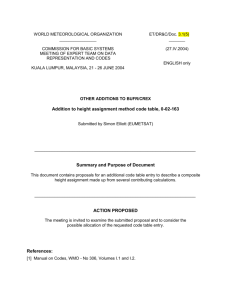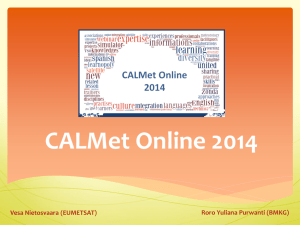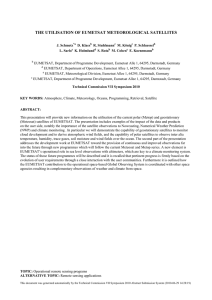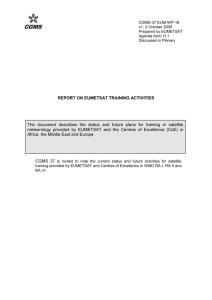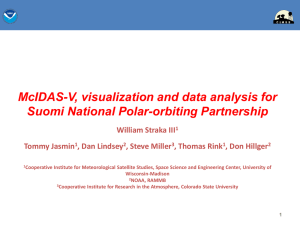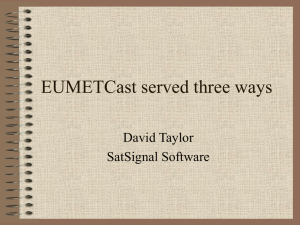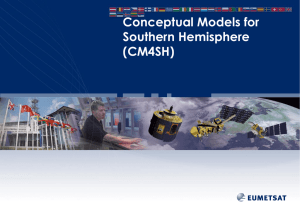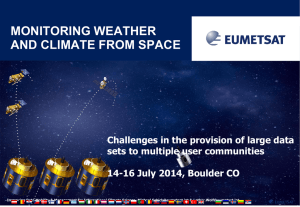Status of EUMETSAT training activities
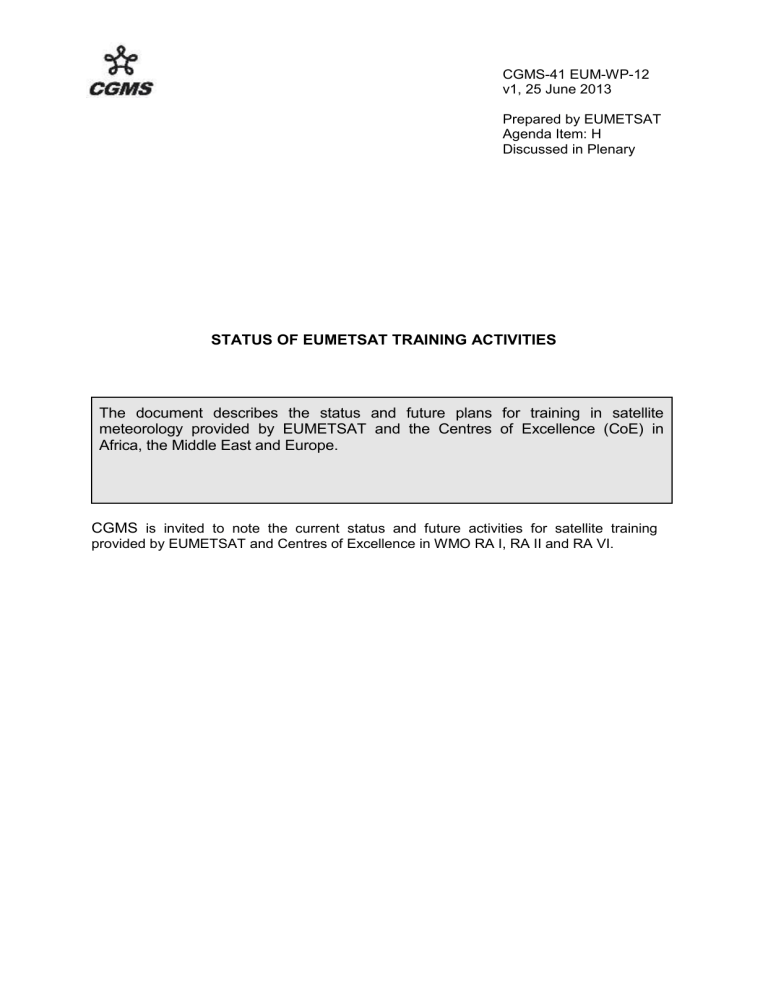
CGMS-41 EUM-WP-12 v1, 25 June 2013
Prepared by EUMETSAT
Agenda Item: H
Discussed in Plenary
STATUS OF EUMETSAT TRAINING ACTIVITIES
The document describes the status and future plans for training in satellite meteorology provided by EUMETSAT and the Centres of Excellence (CoE) in
Africa, the Middle East and Europe.
CGMS is invited to note the current status and future activities for satellite training provided by EUMETSAT and Centres of Excellence in WMO RA I, RA II and RA VI.
CGMS-41 EUM-WP-12 v1, 25 June 2013
Status on EUMETSAT training activities
1 INTRODUCTION
The mandate of the training activities of EUMETSAT is described in the EUMETSAT
5 years training plan, which covers the period 2014-2018. Further guidance on
EUMETSAT long term training is given in the EUMETSAT training framework document, which was approved in 2012 by the EUMETSAT Council. In these documents also the scope of the EUMETSAT contribution to the WMO Virtual
Laboratory (VLab) is described. The User Service Training Team is responsible for conducting and implementing the training activities and plans.
2 EUMETSAT COURSES AND WORKSHOPS
EUMETSAT continued with the organisation of courses, workshops and seminars at the Centres of Excellence and increasingly also at other locations. EUMETSAT supports management and instructors of the training partners to participate at meetings and conferences. The number of training events is increasing, including the on-line and distance learning activities. Many of these events were organised in cooperation with the EUMETSAT Member States.
The e-learning and blended learning activities are facilitated by the Internet making use of the Moodle course management software which has been completely redesigned and upgraded to version 2.2. Most of the satellite courses organised by
EUMETSAT are hosted on the Moodle server (training.eumetsat.int). Students are now able to self-register to courses. However, access to the internet in the developing countries is still an area of concern. Traditionally courses outside
EUMETSAT Member- and Cooperating States are organised at the Centres of
Excellence (CoE), but not exclusively.
3 THE CENTRES OF EXCELLENCE
3.1 Institute for Meteorological Training and Research (IMTR), Nairobi, Kenya
The policy of EUMETSAT is to optimise the training efforts as much as possible.
Often this can be achieved through bundling of efforts with other partners such as was done with the European Union (EU) funded AMESD project. One of the objectives of the AMESD project was to replace the PUMA receiving stations in the
African countries. Synergie, developed by Météo France, was selected as the tool visualisation of data disseminated through the EUMETCast service. This required training for the beneficiary partners, which is in principle the same target group as for the EUMETSAT training activities in Africa (RA I). AMESD has now come to an end, there is a follow on EU project (MESA) which will include the refurbishment of reception stations and an upgrade to the Meteorological visualisation system. At the end of MESA NMHSs should be in a position to assess the benefits of integrated
Page 2 of 7
CGMS-41 EUM-WP-12 v1, 25 June 2013 display systems and argue for the resources required to meet the national need. A follow up continental wide project with similar objectives is not envisaged. MESA addresses wider environmental themes (as did AMESD) and specifically aims to increase the use of EO data for analysis in national regional and continental policy making within sub-Saharan Africa.
The courses held with IMTR, Nairobi, have been instrumental in enabling forecasters in the Anglophone countries to understand how the Synergie system is used, and how satellite data can be used in the forecasting process. This will carry one under the MESA project. In 2013 IMTR and EUMETSAT hosted an online course on the principles of Remote Sensing. This is followed up with a face to face course held at
IMTR in July 2013.
Another major achievement is the installation of training laboratories at the Centers of
Excellence, including IMTR, in the context of the MESA project. These laboratories will be used also for the regular EUMETSAT courses in the future.
3.2 Ecole Africaine de la Météorologie et de l’Aviation Civile (EAMAC),
Niamey, Niger
The tenth EUMETSAT Satellite Application Course (ESAC) course for the French
African community was organised in November 2012. During this two weeks course, the latest developments on satellite meteorology, applications and operations were explained to the participants of the 20 countries. In addition to the participants of the countries also participants from local organisations were invited. This course will continue with the eleventh edition in November 2013.
Also at EAMAC the recently installed AMESD training laboratory continues to provide superb capacity building in the region. This laboratory has been used already in previous courses, and keeps to be essential for the mixture of on-line and face-toface phases foreseen in November 2013.
Two trainers from this Centre of Excellence participated in June 2013 in the preparation meeting for a new phase of the ASMET project.
3.3 Oman
A two week EUMETSAT Application Course (ESAC) was organised at the Sultan
Qaboos University (SQU) in February 2013 for the benefit of meteorologists of the
Middle East, and Egypt. Participants from countries with low incomes per capita were fully supported by EUMETSAT. Those from more wealthy countries in the region were invited, free of charge. Mission costs for participants from these countries were funded by their home services. It is encouraging that all countries from the region were represented.
Page 3 of 7
CGMS-41 EUM-WP-12 v1, 25 June 2013
3.4 SAWS
In 2010, the South African Weather Service (SAWS) in Pretoria upgraded its status from a regular training institute to the level of CoE in satellite meteorology in the
VLab frame by committing to the requirements of WMO. Also in 2010, a new AMESD training laboratory was installed at the training centre at SAWS in Pretoria. Since
January 2011, the CoE in Pretoria now organises monthly online weather briefings
(similar to what the Caribbean group is doing). During the briefings, a short presentation on a small satellite topic is given by an expert. This is followed by the detailed weather discussion of the actual weather situation. The Eumetrain ePort tool proves to be an essential tool for the preparation of such briefings.
The second official satellite course of the CoE in Pretoria took place at SAWS facilities in April 2012. A NOOA expert participated at this course. Special focus was given to microwave products, with a number of case studies for the South African region (with some quizzes). Overall, the concept of a mixture of repeated lectures (as refreshers) and new material on specific topics proved to be very successful. Also, the pre-and post-course tests were well received. The results of the tests indicate a clear improvement in satellite knowledge and satellite image interpretation. The next satellite application course of the CoE in Pretoria is planned for November 2013.
3.5 DNM Casablanca
DMN Maroc is now formally a centre of excellence. A course on nowcasting and marine application was held in May 2013. DMN Maroc plans to host an online aviation course later in 2013, and is also gathering the training requirements for a
North Africa extension to the MESA work.
4 COURSES ELSEWHERE
As in previous years EUMETSAT continues to also support the user community in
South America. A course was organised in Santo Domingo, in the Dominican
Republic, from 15 to 26 October 2012 in unexpected coincidence with the passage of
Hurricane Sandy through the neighbour island of Cuba. This was the 9 th edition of the
Latin American workshop on Satellite Meteorology that EUMETSAT has sponsored and co organised together with AEMET. Participants from the countries with tropical climate participated in the course, with a syllabus focusing on tropical meteorology from satellites: Brazil, Costa Rica, Cuba, Dominican Republic, Ecuador, El Salvador,
Honduras, Nicaragua, Panama, Peru, and Venezuela.
The third EUMETCast User Training meeting was organised in Gramado, in Brazil from 23-28 September 2012 in cooperation with the National Institute for Space
Research (INPE). Participants from Argentina, Brazil and Peru attended this course.
Based on the results of a 2011 course in Lisbon a course on satellite products for land application was organised in Niamey (Niger) at AGRYHMED (19-23 November
2012) in cooperation with the WMO, the Land SAF, the WMO SDS_WAS project, the
SALGEE expert group for drought and fire monitoring. The participants came from 11 countries belonging to the Metagri initiative of WMO. The aim was to prepare field
Page 4 of 7
CGMS-41 EUM-WP-12 v1, 25 June 2013 managers in establishing a network of measuring instruments for precipitation and temperature.
A second course Training Course, in support of the WMO SDS_WAS project, with the topics of Satellite Meteorology and Remote Sensing of Atmospheric Sand and
Dust Storms took place in Antalya (Turkey) on 21 to 25 November 2011 (after the first one in Barcelona in 2010). The third course is now foreseen for December 2013 in Muscat (Oman).
EUMETSAT and NOAA have held courses on the marine forecast application of wind and wave data. These courses are a contribution to the wider JCOMM activities. In
2012 a course was held in Brazil with support from NASA for participant travel and in
2013 we hope to offer a course in South Africa. Extension to the Asia-Pacific region would be possible if there would be a suitable partner from that region.
In cooperation with the Climate Monitoring SAF a workshop for experts will be held in
Helsinki, Finland, from 30 August to 3 September 2013. At this workshop interactive software packages were used to produce climate products for the participating countries.
Last but not least, EUMETSAT in cooperation with CNMCA (Italy) and the University of Madison and the SSEC (Wisconsin) continue to organise the international remote sensing summer school in Italy (September 2011, June 2012, June 2013). The objective of this 7-day course is the in depth explanation of methods and techniques used to extract information from environmental satellite data, with emphasis on the latest measuring technologies. In 2011, the summer school was completely rebuilt with a new logic and structure, more microwave lectures/labs and new pre- and postcourse tests. The structure of the lectures/labs does not follow the traditional instruments or electromagnetic spectrum approach (from VIS, NIR to IR and MW) but follows the scattering/absorption properties from very small particles (atmospheric gases) to aerosols, cloud droplets to much larger precipitation particles. Instead of a block of labs in the afternoon, the labs are distributed in the morning and afternoon hours so that participants can immediately apply and test their new knowledge on specific case studies.
5 DISTANCE LEARNING ACTIVITIES
Distance learning and e-learning activities are becoming a regular training activity and are becoming much more mature as experience is building. A good example is the Precipitation event week in February 2013 – an online training event to highlight the importance of EUMETSAT satellite data for the monitoring and estimation of precipitation. This training week consisted of eight online sessions dealing with the monitoring precipitation from space. The event consisted of three topics: VIS/IR
Precipitation Estimates, Microwave Precipitation Estimates and Multi-sensor
Precipitation Estimates. During the training event week, 150 individuals and groups attended the live online sessions and contributed actively to the discussions or played back the recordings shortly after the live sessions. The sessions will be
Page 5 of 7
CGMS-41 EUM-WP-12 v1, 25 June 2013 converted into webcasts later and added into EUMETSAT Training Library, so the resources will be available for everyone.
At the occasion of the inauguration of a EUMETCast receiving station an introduction to satellite applications was given at a course in Kaliningrad in support of the Russian
CoE at RSHU (St. Petersburg), to stimulate professors and students to use the data received at this station.
ASECNA as the parent organisation of EAMAC organised a one week workshop in
Niamey, Niger from 2 to 6 April 2012. 7 countries were represented. Subjects were the use of Moodle, SabaMeeting and specific applications of satellites to dust and ash monitoring.
In the years 2011-2012, the implementation of the Satrep online system (now called ePort), which is part of the EUMeTrain training project, continued. Several areas have been added to this online training tool: southern Africa, Middle East, polar region and the Atlantic region. Also, a number of new parameters and satellite products have been added (e.g. the ASCAT winds). The ePort system is now the basis for the monthly online discussions and for the preparation of case studies. See link at: www.eumetrain.org
.
6 MANAGEMENT SUPPORT
The progress of the VLab of the reporting period is considerable (see WMO VLab
Web site at: vlab.wmo.int). This could only be achieved by the active support of the
Technical Officer and the secretarial support from EUMETSAT. It is essential that a modus will be found to secure this support.
7 TRAINING MATERIAL DEVELOPMENT AND DISTRIBUTION
ASMET6 training modules are available through dedicated ASMET section at
COMET website. ASMET6 covers three topics: Satellite Precipitation Products for
Hydrological Management in Southern Africa, Flooding in West Africa and 2009
Drought in East Africa. In December 2012 a project meeting was held at EUMETSAT for the ASMET7 project. ASMET7 modules cover aviation hazard topics in Africa and will be completed by the end of 2013. ASMET modules are developed in cooperation with COMET, which results in the fast production of training modules for the African community.
The main part of EUMETSAT training material is distributed online (Moodle Learning
Management System, external training library). On case to case basis training material is also distributed as hard-discs or USB sticks at training events in Europe,
Africa and the Middle East.
EUMETSAT together with WMO funds a project on developing Conceptual Models for Southern Hemisphere. This is a joint project between four southern hemispheric
Centres of Excellence: Argentina, Australia, Brazil and South Africa. The purpose of
Page 6 of 7
CGMS-41 EUM-WP-12 v1, 25 June 2013 the project is to improve warnings and awareness of weather risks through the use of conceptual models within the regions of respective Centres of Excellence.
8 CONCLUSION
CGMS is invited to note the current status and future activities for satellite training provided by EUMETSAT and Centres of Excellence in WMO RA I, RA II and RA VI.
CGMS is invited to make recommendation for a continued support of the VLab technical officer.
Page 7 of 7
